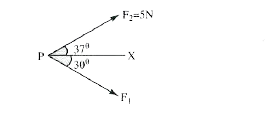Explain how from Newton.s 1st law of motion the qualitative idea of inertia and force develops.
Newton.s first law: If a body is in a state of rest, it will remain in the state of rest and if the body is in the state of motion, it will remain moving in the same direction with the same speed unless an external force is applied on it.
(i) Qualitative idea of inertia: The 1st part of Newton.s first law of motion gives the qualitative idea of inertia. Inertia is the property of a body by virtue of which it tends to continue its state of rest or of uniform motion.
(ii) Qualitative idea of force: The 2nd part of Newton.s first law gives a qualitative idea of force. Force is the external agency which when acts on a body can move a stationary body or which can stop a moving body.
Topper's Solved these Questions
- LAWS OF MOTIONBOOK - ICSECHAPTER - LAWS OF MOTIONEXERCISE - TOPIC 3 (2 Marks Questions )
9 Videos
- LAWS OF MOTIONBOOK - ICSECHAPTER - LAWS OF MOTIONEXERCISE - TOPIC 3 (3 Marks Questions )
7 Videos
- LAWS OF MOTIONBOOK - ICSECHAPTER - LAWS OF MOTIONEXERCISE - TOPIC 2 (3 Marks Questions )
11 Videos
- ICSE ANNUAL EXAMINATION -2020BOOK - ICSECHAPTER - ICSE ANNUAL EXAMINATION -2020EXERCISE - SECTION-II
45 Videos
- LIGHTBOOK - ICSECHAPTER - LIGHTEXERCISE - TOPIC 2 Spherical Mirrors (4 Marks Questions )
9 Videos
Similar Questions
State Newton.s second law of motion.
View SolutionWhich of Newton's laws of motion explain the concept of inertia ?
View SolutionFrom Newton's second law of motion, it can be inferred that
View SolutionHow can Newton.s first law of motion be obtained from the second law of motion?
View SolutionIn accordance with Newton’s third law of motion -
View SolutionHow does Newton's second law of motion differ from first law of motion ?
View SolutionA moving bicycle comes to rest after sometime if we stop pedalling it. But Newton's first law of motion that a moving body should continue to move for ever, unless some external force acts on it. How do you explain the bicycle case?
View SolutionState the Newton's laws of motion. What is the SI unit of force ?
View SolutionWrite the mathematical form of Newton.s second law of motion. State the conditions if any.
View SolutionAccording to Newton.s second law of motion, resultant force on a particle is in the direction of acceleration of the particle. Two forcce F1andF2 are acting on a particle as shown in the figure. The acceleration of the particle is along X-axis. FInd the value of F1 (in newton)

View Solution
